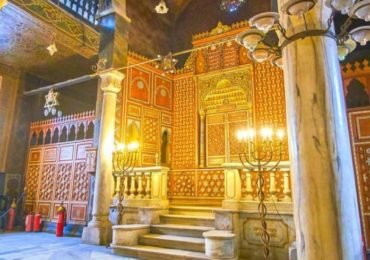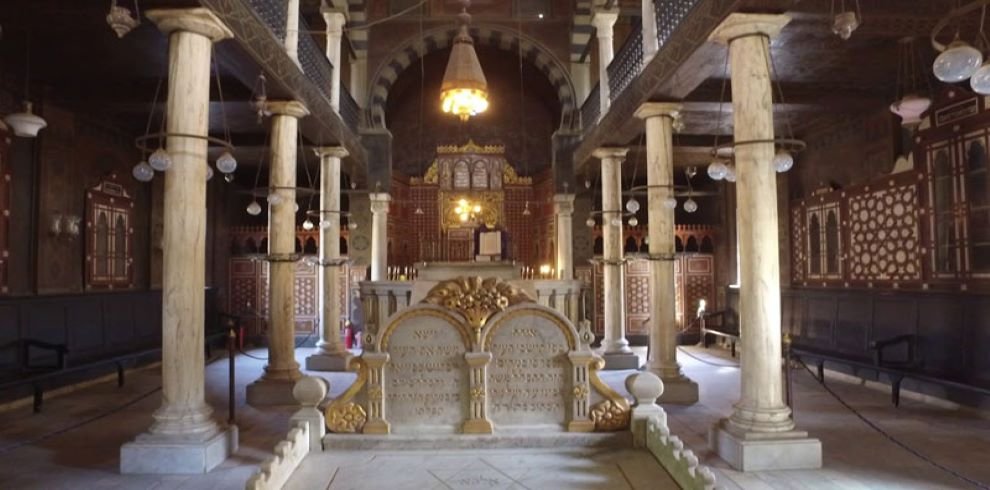Ben Ezra Synagogue in Cairo is one of the most important and largest synagogues in Egypt. Let’s take a look first at the history of Judaism and Jews in Egypt.
Looking back in time, we can see that Egypt welcomed Jewish refugees from all over the world with open arms. The Jewish community in Egypt lived always in peace with the other Egyptians. This community was centered in Cairo and Alexandria. Jews in Cairo lived in a special area known as the Lane of the Jews in Mosky, Cairo.
Egyptian Jewish had a great deal of freedom in practicing their religion and establishing synagogues, charities, schools, and institutions. They worked in a variety of maritime, commercial, and industrial jobs. As they crafted jewelry, they became acquainted with the Egyptian nobility. Because some Jews in Egypt spoke very good Arabic, they were given high-ranking positions in the government.
Throughout the years, the Egyptian Jewish community has maintained a high social level. It eventually becoming the most developed community in the Middle East. Some of them achieved great success, wealth, and power in Egypt.
Ben Ezra Synagogue
Ben Ezra Synagogue is located in Old Cairo District near the Coptic Museum, the famous Hanging Church, and Abu Serga Church. The Synagogue is named after the great Jewish Rabbi Ezra the Scribe. Synagogue of Ben Ezra is one of Egypt’s largest synagogues. This synagogue was originally an orthodox church. Then, it was sold to Jews for 20,000 Dinars in 882 AD, to pay the taxes levied by Egypt’s ruler, Ahmed Ibn Tulun.
It was thought that the location of the synagogue was where Moses prayed for the plague recovery that hit Egypt. It is also said that Moses and Armia are prostrated here. Another story goes that the prophet Eliya or Eliyahu appeared to the people there several times. According to these stories, it was a synagogue that was converted into a church and then back into a synagogue.
Ben Ezra Synagogue, as well is one of Egypt’s oldest synagogues. It is also one of the most significant synagogues in the world due to the discovery of the Geniza in one of its rooms. The Geniza is a collection of old papers and documents that were kept in one of the synagogue’s rooms. Jacob Safir discovered it in 1896. This Geniza contains a wealth of information about the social and economic history of Jews in Egypt.
The word Geniza is Persian in origin. It refers to hidden knowledge as well as the Rabbi’s thoughts on the perfect place for good souls. Geniza could also refer to the location in the synagogue where these important and religious documents are hidden. Because they bear the name of the god, these papers and documents should be preserved and buried. In Arabic, the word Geniza means “burying” or “burial.”
Description of Ben Ezra Synagogue
The synagogue was built in 882 AD. Due to its deplorable conditions, the Jewish community decided to demolish it in 1890. A new synagogue was constructed. In 1991, the Egyptian government, in collaboration with the Canadian Center of Architecture, renovated it and turned it into a tourist attraction.

The current Ben Ezra synagogue faces Jerusalem. It is designed as a two-story basilica. First floor is reserved for men, while the second floor is reserved for women. The first floor is divided into three sections, the largest section of which is the middle one. There are some lovely marble pillars with magnificent capitals. The niche of the synagogue is to the east while the synagogue’s ritual items are in the center. A Rabbi’s pedestal for the Saturday sermon and the Torah ark is in the middle of the ritual stuff.
While the second floor is reserved for women, and it has a window that overlooks the first floor. The famous Geniza Room is located at the end of this flood. It is a closed room on all sides except the top. Where sacred and important papers were thrown for a long time. It was discovered in 1896, and the contents were transferred to Cambridge University.
A chandelier inscribed with the names of the four rightly guided Muslim caliphs, Abu Bakr, Omar, Othman, and Ali, graces the synagogue. Another copper chandelier bears the Mamluk Sultan Qaloun’s name. The Mamluk Sultan Qaloun Ibn Abdullah Al-Alfy, who ruled Egypt between 1280 and 1290 AD, presented the synagogue with these two chandeliers.
How to get to Ben Ezra Synagogue from Cairo?
To reach the Synagogue of Ben Ezra in Old Cairo from central Cairo, follow these steps:
By Metro:
- Take the Cairo Metro Line 1 (the red line) and head towards the Mar Girgis Station.
- The Ben Ezra Synagogue is just a short walk from the station exit, located within the Coptic Cairo area.
By Taxi or Ride-Hailing Apps:
- Use a taxi or ride-hailing apps like Uber or Careem, and set your destination as Ben Ezra Synagogue or Coptic Cairo.
- The church is located in the Misr Al-Qadima (Old Cairo) district, and most drivers are familiar with the area.
By Bus:
- Take any bus heading to Old Cairo or Mar Girgis Square.
- From the bus stop, it’s a short walk to the church.
Guided Tours:
Egypt Best Vacations offers many daily guided tours that include Coptic Cairo with the Ben Ezra Synagogue and other churches included. These tours include transportation, entrance fees and expert tour guides.

